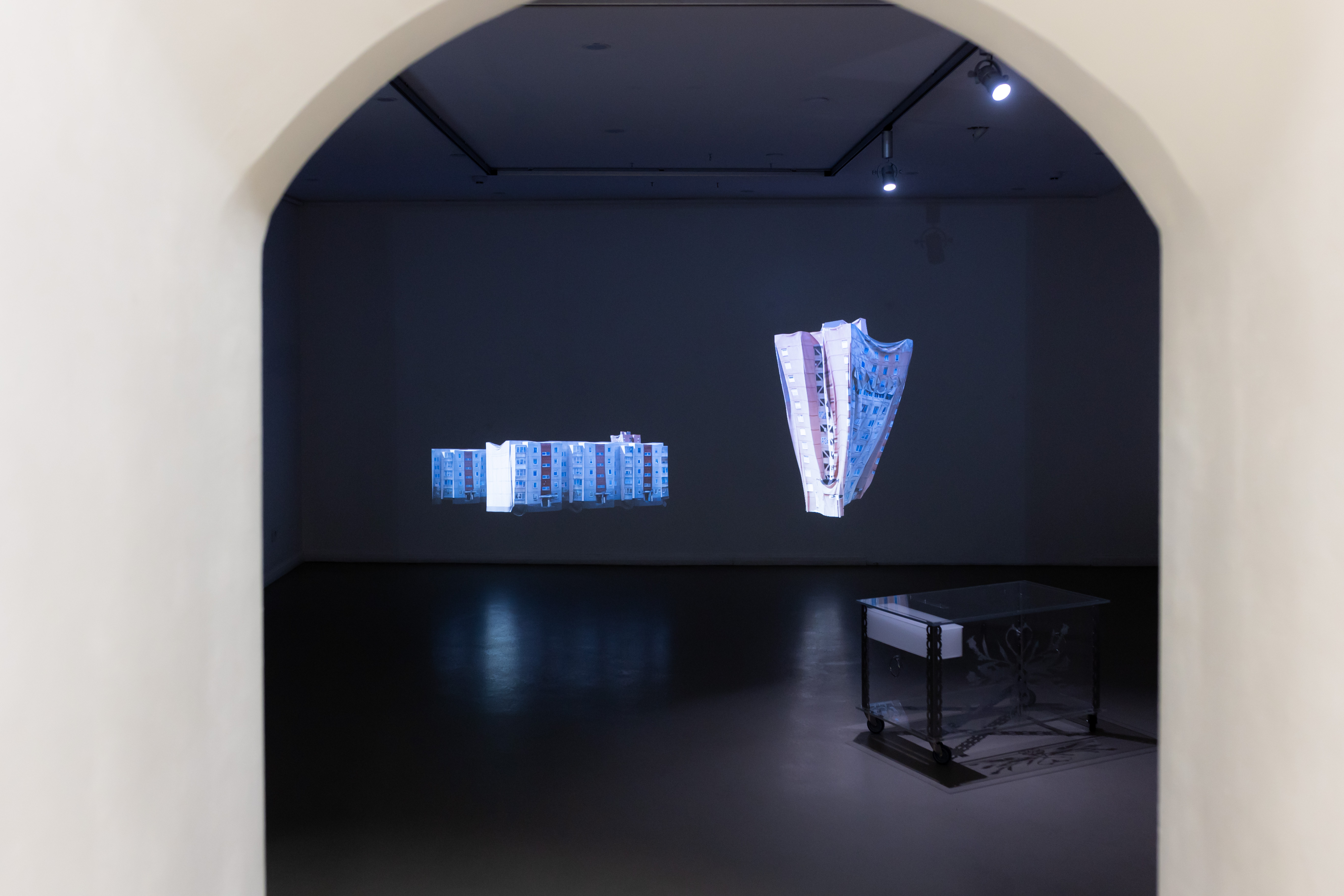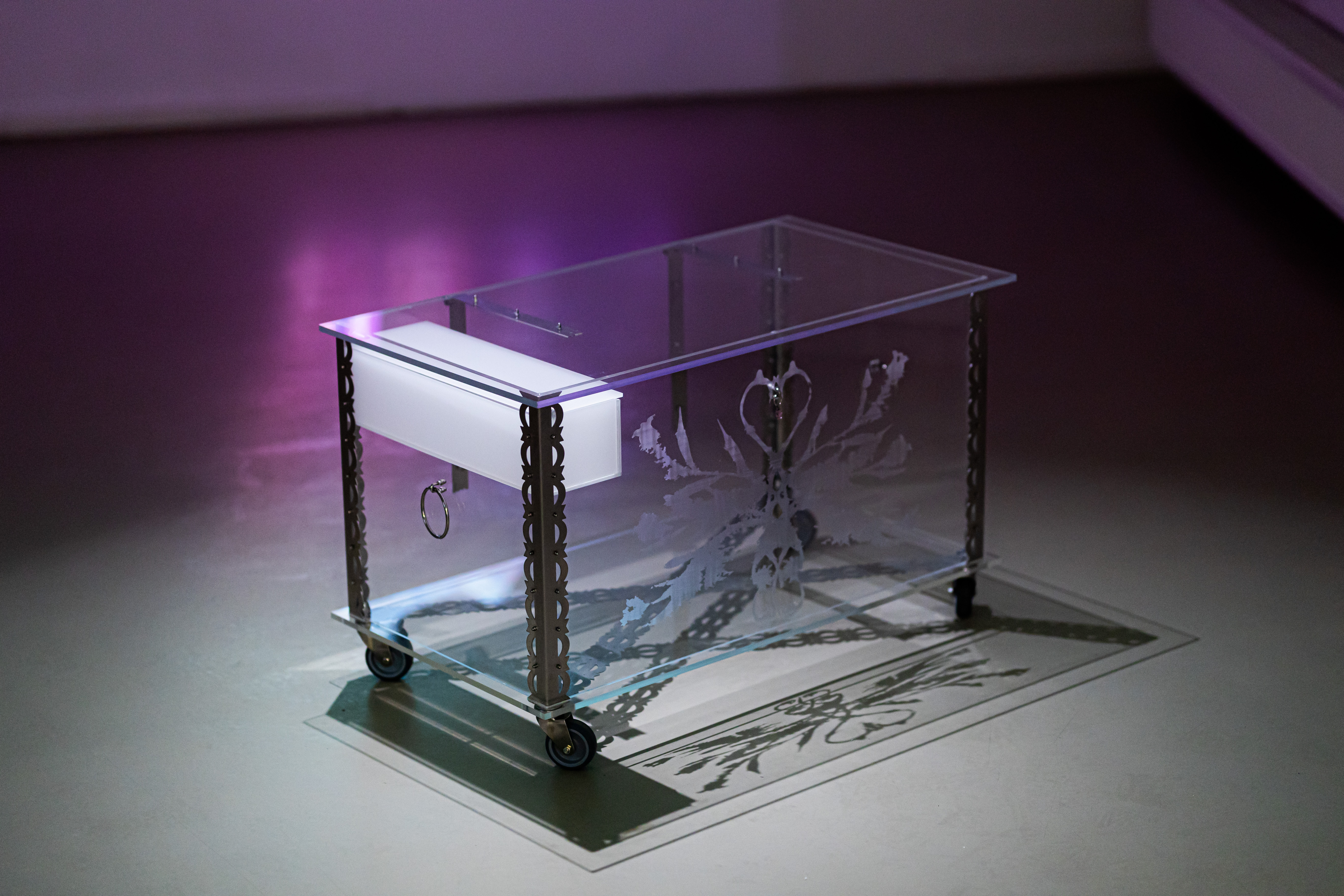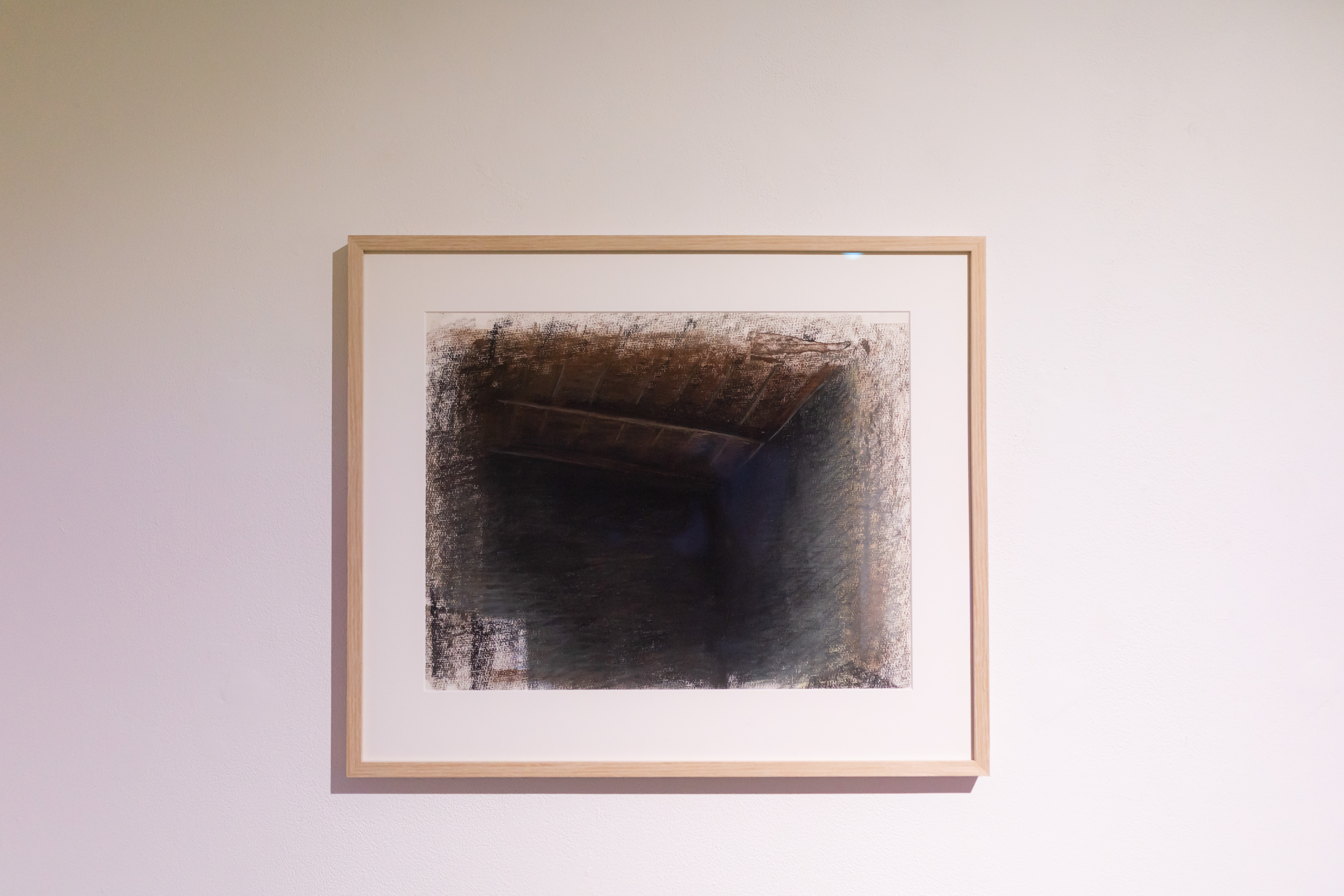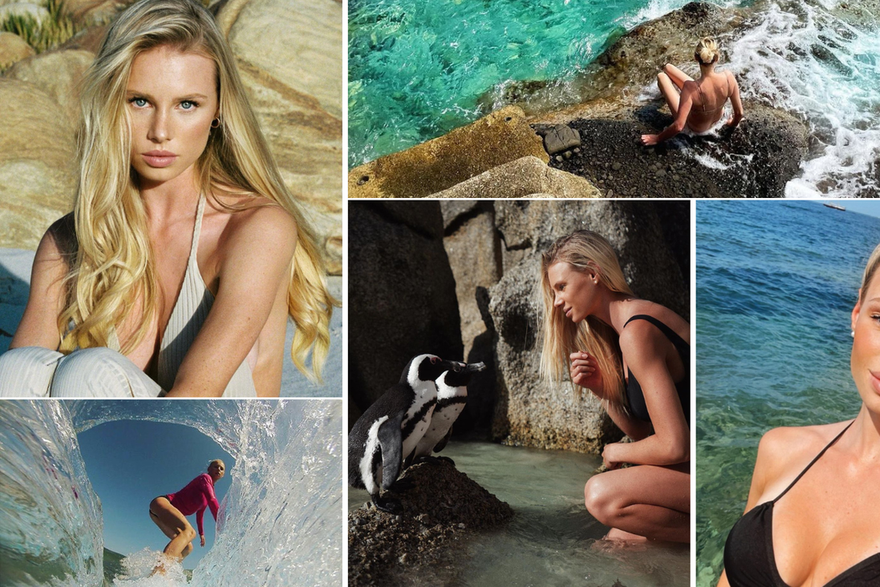In the arms of time
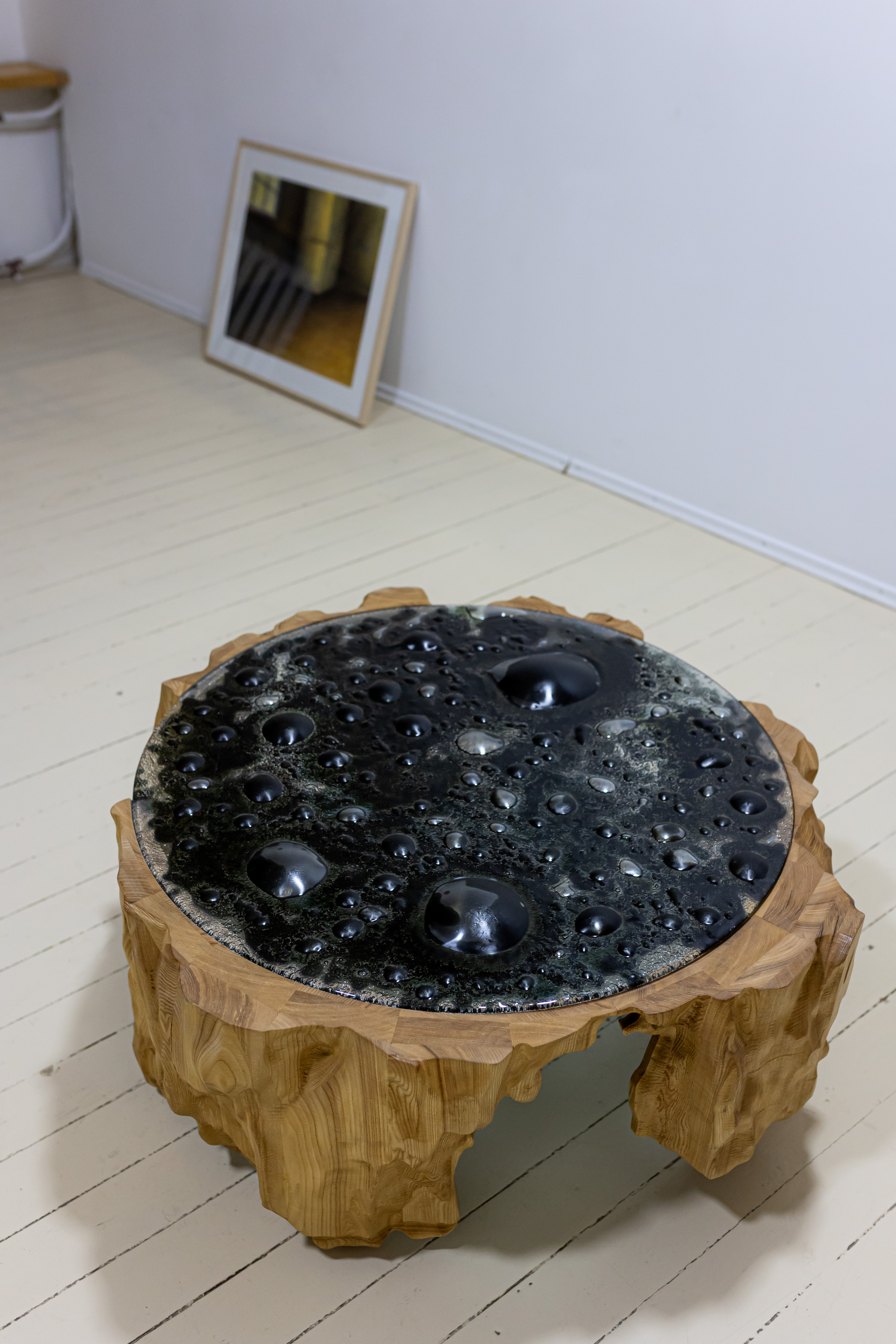
The chamber niche spaces adapted to contemporary art coexes the range of works, but also for the viewer with the independent assortment of works. The authors of the exhibition are known to be two opposite personalities creating in different spheres. It can be seen very vividly in the content of their creative work – the space is intertwined by Ž. Baranauskas’ rich, nostalgic past and P. Vasiliauskaitė’s anxious future motives, which seem to be sore and enriched each other. I doubt whether these works would have such a strong impact on the viewer. Although, of course, the concept of the future also does not work without the past, and vice versa, what just justify the relationship between the works.
Photo by M. Savičiūtė
Interacts with the viewer
In the gallery, Ž. The works of Baranauskas, which are part of the composite work, « Remainable, Pervading Longing of the Home ». They can be seen in the corners of the house – silent, vague, as if pulled out directly from the deepest memories. Such, essentially insignificant, details – as a dusty corner of the house, a fragment of the refrigerator – as if framing memory, give it a background and place to express in consciousness, no matter how the content of the framed image. It is these « skeletons » that are perfectly revealed through pastel, the pulsating fog that allows for links to the concepts of limenality. What was before is no longer now. This feeling is also enhanced by the spaces of the gallery itself. Emptiness, brown, gray tones and abundance of ideological content, and freedom interpreted in a very interesting way interact with the viewer.
Surrounded by Ž. Baranauskas’ works, in the middle of the first hall stands a table. It is quite funny that I was able to think about its non -functionality first – but the table itself should be called the design object. It is sculptural and attractive to the eye, and the bright tree fits earthly and tranquility. Everything else is the glass surface of the object, which resembles a bubble -bubbling cheese. According to the author of the work P. Vasiliauskaitė, the water – It is the limit between myth and reality, childhood memories and future. The title of the piece – « Swamp for Fairys » – is very suitable for the work itself visually. However, the idea gives work and a lot of mysteriousness, it raises questions about memory and destiny.
Photo by M. Savičiūtė
The artist’s elected Lauma character is the manifestation of the goddess of destiny, hiding in a glass whose limal and mysterious nature play with the meaning of reflection. The reflection in the piece acts as a kind of camera that captures the moment, the passerby here and now. In this way, it gives meaning to such an important place and time – the factors needed to make the fate of the fairy -to -be -made fate. Certain opposition to tradition and canons is expressed through unique design methods, combining different glazing techniques. After the story, the question arises today – are the fairies really the blacksmiths of man’s destiny? The materialized boundary of the artist gives meaning to the present in the creation of an intermediate state and helps dark glass. And the viewer’s freedom of reflection allows the work to act without much engagement or interactivity of the viewer.
Time -tested strategy
The works in the first hall look extremely clean, moderate, which allows the gallery air to glide freely and the viewer’s thoughts. This « cleanliness » motif accompanies the entire exhibition. However, the next hall is a bit darker, which is ideal for the Ž. Baranauskas’ video work, but she, inadvertently, creates a strong impression of intimacy and even harshness. When the viewer climbs the steps to the second hall, there is no choice but to come to the confrontation with yourself and delve into the works independently. This subtle but still transformed moment is a high quality, time -tested curative strategy that invites the viewer to engage unconditionally to the exhibition. This is also encouraged by a small number of works, so the viewer’s focus is not disappointed with a bunch of art and impressions.
Photo by M. Savičiūtė
When entering the hall, the eyes first notice the animation (loop) in front, where the black background depicts Soviet apartment buildings. This is another part of the « relentless, all -long home longing », where Ž. Baranauskas emphasizes longing. In addition to animation, video work can be seen. It is he who helps to understand more about why and what is the animated buildings. The artist’s works are an ode to the past, survived for childhood period. The ephemeral content of Soviet apartment blocks is a residence, a spectrum from good to bad memories. The image in the clip is deeply personalized, the author, like a small child, walks around the cold, concrete apartment walls, which he tries to cover with warm human hands and hug them. The idea of longing for such a tactile body is not wrapped in conceptual layers, it is very simple and earthy, and every viewer is easily felt. The contrast and the unconditional desire to catch up with the past manifest themselves almost infantile, giving the sacred meaning of memory visually and historically unattractive to the Soviet leg. It is revealed within the beholder, patting the head of such a popular inner child in psychology terminology.
Photo by M. Savičiūtė
When it comes to animation, it depicts the same Soviet monoliths floating like a fluffy curtain. An animation response to a hug clip is a very interesting moment that transforms static apartment buildings into a soft, fluid fabric that can be hugged and caressed. It can be dressed, hidden beneath it, and drowned in the challenged memories. However, that fabric can be thoroughly suffocated – it is easy to stay too long in memories, which interferes with the personality to spread and seek full potential. This, in my opinion, the cornerstone in terms of subjective nostalgia, was left untouched – although sometimes it is really nice to escape the deeper corners of the soul and allow ourselves to long for longing. It is not necessarily to be an excessive pain or a stubborn experience In the summary – Rather, only a sensitive look to the genesis of personality.
On the right from the center of the second hall there is a translucent, glass, empty box. Like the object « Swamp for Fairys », it raises confusion and more than one question. However, all the works of the exhibition unfold through the physical form, but through the prism of consciousness – P. Vasiliauskaitė’s glass « Downtrich Back » is no exception. It is decorated with steel, plastic, natural -like ornaments, which are also modern – pointed ornaments highlighted a bit reminiscent of rebellious tattoos. The heart in the middle of the glass surface is playfully blending into the common ornament.
Photo by M. Savičiūtė
Again, the artist is based on memories, when she herself saw a real wooden chest of the great -grandmother’s downtown. With the help of past fragments, it reflects about the future where the archaic object as a dowry chest loses its meaning. For a modern woman, neatly dissolved in industrial, constantly innovative and unrest in a society, marriage is far from the most important event of life that determines her place in the world. Therefore, the glass chest is actualized through its materiality and shape – as if dissolved in time and the viewer, much like the « swamp for the fairies », it reflects its own perception and to set up the past – history. The chest is empty – its contents are unpredictable, not identified by external factors, and promise happiness, perhaps even in an unstable future world. It is perfectly touched on the theme of femininity and identity, presented as restlessness, questioning of traditions and even hope. The chest becomes not only a symbol of personal experiences, but also for the collective experience of women. Glass, as a media chosen, enhances the ideological time uncertainty and multi -layered, as it is fragile as the future unreliability, and transparency allows the creation of a unique relationship between the viewer and the artist. The spaced space envelops the work of the mysterious aura, and the chest shines in Ž. Baranauskas Soviet apartment buildings, which further enhance the interaction of the works.
Photo by M. Savičiūtė
Viscous time matter
The works set up in small but not claustrophobically tight spaces create a wonderful dialogue between them. The works are lying in the right places and talking to the viewer only the messages assigned to themselves, and most importantly, talking to each other. This creates a unified exhibition plan that awakens self -reflection, meditation in space and turns the viewer into an active observer. The exhibition is dynamic, not left in linear time. Nor can it hear the slightest sound. Silence leaves the visitor only with his own thoughts, which I think is very effective and valuable in displaying works on time in a broad sense. The aesthetics are taken to the background in the exhibition, and the content provokes the viewer to raise questions about personal relationship with nostalgia and future waiting.
In « being, » the time turns into a viscous matter. It is smoldering from glass walls, confusing around the visitor. The future turns into uneven prickly clumps in the throat, and the mass of nostalgia is almost tangible, but still no longer achieved, locked under several locks of consciousness. Ž. Baranauskas seems to catch the past and give it a physical body, and P. Vasiliauskaitė leaves the thinking process of the future for self -detection, using works only as tools. The time in the exhibition is not calculated, but experienced, using different and seemingly unrelated media, as longing as waiting, but first and foremost, it is indefinite. The exhibition raises personal questions, but does not offer easy answers to them. Artists also invite you to rethink how much we really belong to ourselves, and how much to the environment, for the time of time on experiences and emotions and the boundaries of the period. The personal connection with the works forces me to think about one’s memories, for the other, it can only become a testimony to the shadow of a foreign past. Finally, the « creature » reminds that time can be not only memory and a full longing, but also a subtle opportunity – to wait hopefully, to understand again. Even run.

